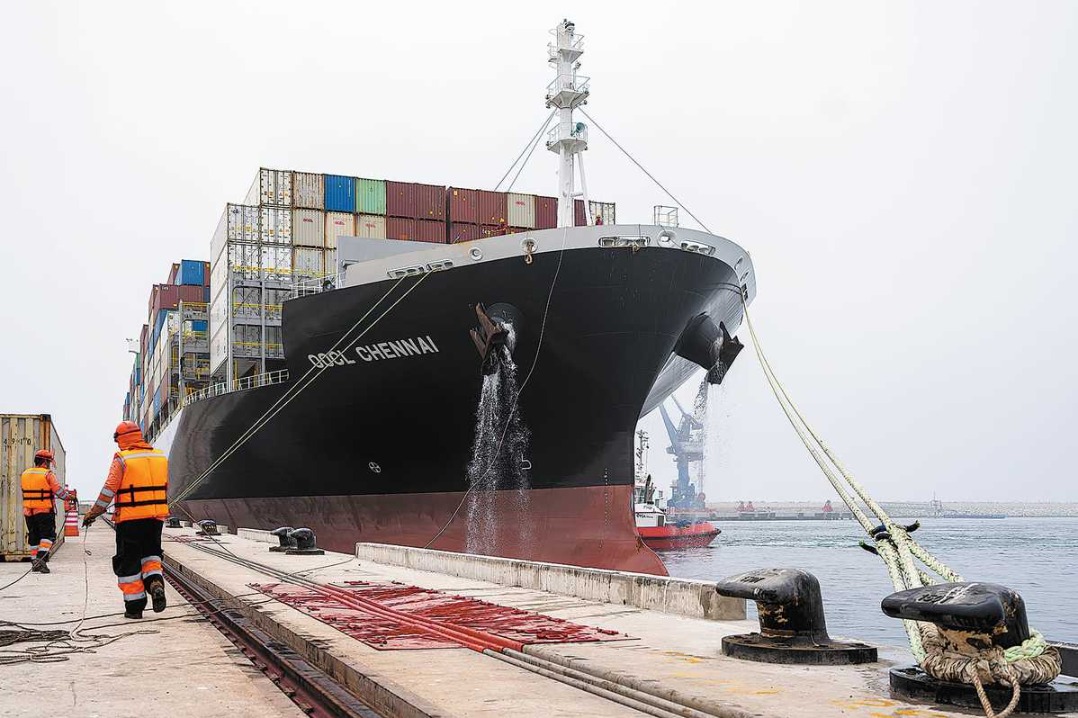Megaport in Peru redefines trade relations
Built with Chinese support, it shortens shipping time, reducing logistics costs


For decades, Chancay was a quiet town north of Lima, Peru, better known for its fishing community and slow rhythm. That changed after the Chancay Port was officially inaugurated in November 2024.
Built in just three years through Chinese-Peruvian collaboration, the port shortens the shipping time across the Pacific by nearly one-third, reduces logistics costs by 20 percent and is expected to directly create more than 8,000 jobs.
Since then, cargo ships have been docking in record numbers. Following the launch of a direct corridor with Shanghai, ships now run twice a week, carrying goods such as fish meal, fruits and copper eastward and bringing back a slew of manufactured goods from the large manufacturing bases in Asia. For exporters and importers, this regular service has ensured speed and certainty.
"The Port of Chancay is the first port on South America's Pacific coast capable of handling large-capacity container ships," said Rosa Elis Teles Galletta, a researcher at the Federal University of Rio de Janeiro. "Its inauguration not only connects Peru to the Chinese market but also redefines trade relations throughout the region, particularly through the connection between the Atlantic and Pacific oceans."
The outsized influence of the port may be most visible on Chancay's main boulevard, where storefronts brim with imports like toys, kitchenware and flasks. Local traders have been importing such goods at lower cost and distributing them swiftly.
Figures reflect how quickly the megaport is reshaping trade. In the first six months of 2025, shipments along the Chancay-Shanghai corridor totaled 78,000 metric tons with a value of 1.72 billion yuan ($241 million), pushing trade between the two hubs up by nearly 35 percent, according to data from Shanghai Customs.
Products such as avocado, mango and blueberry are now shipped directly to China in greater volumes. On July 4, Shanghai's Yangshan Port received the season's first blueberry consignment from Chancay, 11.7 tons in total.
To help small businesses participate in the boom, the Chancay Chamber of Commerce launched its "Importing is Easy" program, which guides entrepreneurs through customs, formalization and access to global supply chains.
"These initiatives are important because they provide local users with the tools and advice they need to conduct their foreign trade operations efficiently, as well as to increase their profitability, improve operational processes, and take advantage of business opportunities," said Ruben Tang, head of the Office of Relations with Asia at the Pontifical Catholic University of Peru.
The benefits, Tang notes, extend far beyond trade.
Ripple effects
With the port at their doorstep, Chancay could see ripple effects from tourism, logistics, commerce and real estate with new transport services and hotels opening up along with trading companies and housing projects.
Tang believes the model can be replicated elsewhere in South America, helping smaller cities grow through logistics modernization and improved access to international markets.
"It can also serve as a model for addressing the challenges of the external market with greater confidence and capacity," he added.
Built to Chinese standards, the megaport features automation and its own 5G network, placing the terminal in Peru on par with the world's most advanced terminals.
"The infrastructure represents a significant advance for Peru's logistics network and allows port workers, mostly Peruvians, to gain experience operating a terminal comparable to the most modern in the world," Galletta explained.
Chinese migration to Peru dates back to 1847 but the long relationship has strengthened over the past couple of decades, culminating in the China-Peru Free Trade Agreement signed in 2009. Peru joined the Belt and Road Initiative a decade later.
China has been Peru's largest trading partner for 10 consecutive years, accounting for up to 39 percent of Peruvian exports.
The writer is a freelance journalist for China Daily.

































